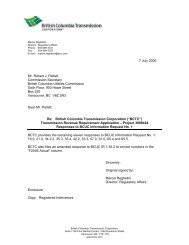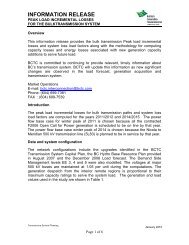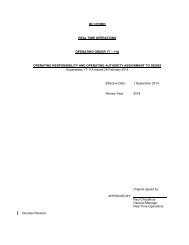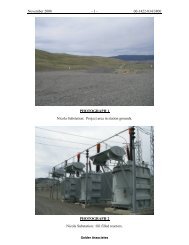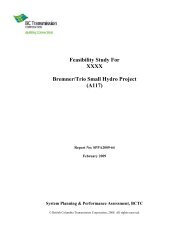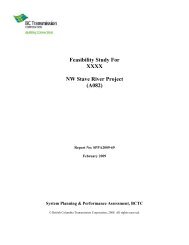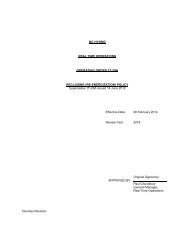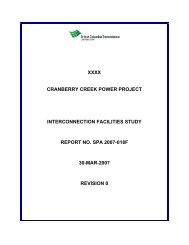Evidence on the Adequacy of First Nations Consultation - BC Hydro ...
Evidence on the Adequacy of First Nations Consultation - BC Hydro ...
Evidence on the Adequacy of First Nations Consultation - BC Hydro ...
You also want an ePaper? Increase the reach of your titles
YUMPU automatically turns print PDFs into web optimized ePapers that Google loves.
DRAFT REPORT: Rights and Title Interests in <strong>the</strong> Columbia Valley Transmissi<strong>on</strong> Project Area<br />
Alice Belleau <strong>of</strong> Alkali Lake also opined that she did not know <strong>of</strong> any Shuswap-wide<br />
organizati<strong>on</strong> that united <strong>the</strong> bands, but that <strong>the</strong>ir relati<strong>on</strong>s were friendly. 304 O<strong>the</strong>r resp<strong>on</strong>dents<br />
supported <strong>the</strong> c<strong>on</strong>cept <strong>of</strong> <strong>the</strong> totality <strong>of</strong> unbounded band lands comprising <strong>the</strong> territorial holdings<br />
<strong>of</strong> <strong>the</strong> Secwepemc people.<br />
Pierre Squinahan <strong>of</strong> Alkali Lake resp<strong>on</strong>ded to <strong>the</strong> questi<strong>on</strong> about individual band boundaries<br />
before Europeans came by saying:<br />
There was no real boundary. The different bands lived in different places<br />
by <strong>the</strong> land bel<strong>on</strong>ged to all <strong>the</strong> Shuswap. 305<br />
David Johns<strong>on</strong> also distinguished access to hunting grounds, available to all Shuswap people,<br />
from access to fisheries and to village sites, <strong>the</strong> property <strong>of</strong> a residential group, but he, too,<br />
stressed <strong>the</strong> undifferentiated territory associated with <strong>the</strong> Shuswap speech-community:<br />
There was no fixed boundary. Each band had its special fishing places<br />
and places where it used to build its winter villages, but <strong>the</strong> land was<br />
bel<strong>on</strong>ged to all <strong>the</strong> Shuswap and any<strong>on</strong>e could hunt where he wanted. 306<br />
Teit also c<strong>on</strong>cluded that each band "had its comm<strong>on</strong> recognized hunting, trapping and fishing<br />
places, but members <strong>of</strong> any o<strong>the</strong>r bands were allowed to use <strong>the</strong>m without restricti<strong>on</strong>, whenever<br />
<strong>the</strong>y desired." 307 Each family was relatively independent and was able to procure and process<br />
what it required, with equal access to <strong>the</strong> same resources as o<strong>the</strong>r families.<br />
Apart from <strong>the</strong> recogniti<strong>on</strong> <strong>of</strong> a comm<strong>on</strong> territory occupied by Shuswap-speaking people, and <strong>the</strong><br />
associati<strong>on</strong> <strong>of</strong> bands or kin-groups with particular territories, <strong>the</strong>re is some data available<br />
c<strong>on</strong>cerning specific hunting locati<strong>on</strong>s that were regulated. Fragmentary data c<strong>on</strong>cerning such<br />
stewardship is provided in <strong>the</strong> ethnographic literature. Boas reports that am<strong>on</strong>g <strong>the</strong> Shuswap,<br />
"tribes [i.e., bands] and families had separate hunting grounds originally" but at <strong>the</strong> time <strong>of</strong> his<br />
investigati<strong>on</strong> am<strong>on</strong>g <strong>the</strong> Kamloops Shuswap [in 1889], this practice was all but forgotten. 308<br />
Boas c<strong>on</strong>trasts this with <strong>the</strong> communal ownership <strong>of</strong> <strong>the</strong> resource and states:<br />
It seems that <strong>the</strong> various tribes <strong>of</strong> <strong>the</strong> Shuswap had no separate hunting<br />
grounds, but that <strong>the</strong>y hunted over <strong>the</strong> whole territory, wherever <strong>the</strong>y<br />
liked...Disputes arising between members <strong>of</strong> <strong>the</strong> same tribe were<br />
generally settled by arbitrati<strong>on</strong>. For instance, where a number <strong>of</strong> men had<br />
driven deer into a lake, and a dispute arose as to who had driven <strong>on</strong>e<br />
304 Brow 1972, page 52.<br />
305 Brow 1972, page 46.<br />
306 Brow 1972, page 49.<br />
307 Teit 1909, page 572.<br />
308 Boas 1891, page 86<br />
Bouchard & Kennedy Research C<strong>on</strong>sultants Page 71<br />
Page 74 <strong>of</strong> 200






